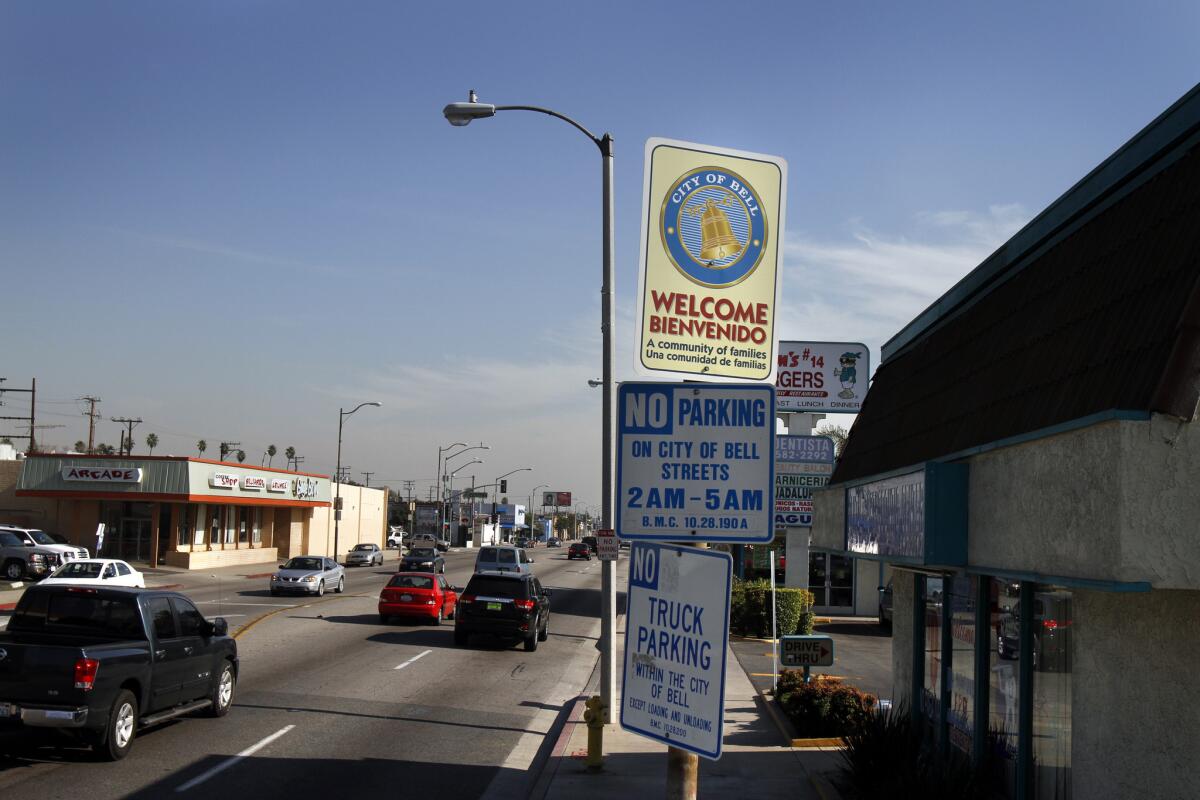Impounded cars boost Bell’s coffers

- Share via
As city administrators’ salaries were rocketing upward in Bell and council members’ stipends were among the highest in the state, the city went on an aggressive push to increase municipal revenue by impounding cars in the city, police officers say.
Officers in this poor, largely immigrant community were pushed to have more cars towed and, at one point, were given what some patrol officers said amounted to a daily quota. Several officers said they were reprimanded when they failed to find cars to tow and were warned that City Hall jobs could be at risk if impounds did not accelerate.
At the same time, the city charged one of the highest impound release fees in the area and benefited from an agreement with a single towing company, from which it collected additional fees every time a car was impounded.
FULL COVERAGE: High salaries stir outrage in Bell
“It really changed our culture,” said police Sgt. Art Jimenez. “Rather than being police officers and being proactive looking for crime, we were out there looking for vehicles to impound.”
Capt. Anthony Miranda, who has helped lead the department since Chief Randy Adams resigned in July, said that officers were never given a quota but that in 2009 they were given a daily goal of towing two cars, writing three moving violation tickets and making one arrest. He said the goal was to make the city an undesirable place for gang members by cracking down on traffic enforcement.
Impounding cars, usually because the drivers are unlicensed, has been a steady revenue stream in Bell for years. In the last fiscal year, the city expected to make more than $770,000 from release fees, which would amount to between 2,000 and 2,500 impounds per year. The previous year, the department made more than $834,000.
The city charges unlicensed motorists a $300 fee to release the car; those charged with driving under the influence are charged $400. The number does not include costs imposed by the impound lot, which starts with a $104 base fee and increases $27 per day.
By contrast, Simi Valley, which has a population three times Bell’s, brings in about $61,000 a year from impound fees and charges $77 to release impounded cars, officials said. In unincorporated Los Angeles County, drivers pay $93 to get a vehicle released. The amount, experts said, is meant to recoup costs involved in towing the vehicle, not to make a profit for the city. In all three areas, additional fees for towing and storage are paid directly to the towing company.
In Bell, towing and storage fees were compounded by an agreement with Bell Tow Service Inc. that allowed the city to collect a separate fee of 10% per impound, which generated tens of thousands of dollars per year.
The enforcement policy may have been aimed at gang members and undesirables, but it put a heavy burden on others too. Dr. Mary Romo was among those who said she witnessed the effect of the aggressive towing practice on the community.
Her patients, some pregnant or in need of medical attention, had their cars towed and impounded so frequently while en route to her office or the hospital that she started keeping track, adding names, dates and ticket information to a folder she kept next to her patients’ medical files. She said she complained to the city but never got an answer.
“This is a real problem. It’s not just my patients, it’s everybody in the community that’s suffering,” said Romo, an obstetrician and gynecologist. “It’s a poor community.”
The result of the crackdown on impounds was a Police Department heavily focused on traffic enforcement, often to the exclusion of other problems, officers said.
For some, the emphasis on impounds meant patrol time was spent pulling over drivers for small infractions in the hope they would turn out to be unlicensed. Although officers didn’t look exclusively for immigrants, it was clear that the majority turned out to be illegal immigrants, Owens said. Undocumented immigrants cannot obtain driver’s licenses.
“We developed an intuition” for unlicensed drivers, said Officer Kurt Owens. “We’d look for younger guys in their 20s and 30s, guys with junkier cars, broken lights, loud music or tinted windows. Sometimes it was a car that stopped 50 feet before an intersection if they spotted you. They’d cross themselves or touch their religious figures.”
Owens, a 23-year department veteran, filed lawsuits last year in federal and state court saying he was punished for refusing to go along with a department-mandated quota for impounds, tickets and arrests. The suits were settled in his favor last week, Owens said.
The emphasis on impounds started early in the decade and fluctuated slightly under the direction of a rotating cast of police chiefs but always remained a key part of the job, officers said.
“It got really bad in 2008, 2009,” Jimenez said. “They weren’t hiding it. They were directly asking for these impounds. Some officers were being called in and asked to impound cars. They would keep these stat sheets on us and it would say how many arrests, how many cites we’ve written throughout the week, month and year.
“In these stat sheets the number they were really looking for was impounds.... That’s not the way police work should be measured,” he said.
Officer Gilbert Jara, president of the Bell Police Officers Assn., said officers were called in and told to increase impounds.
“If you weren’t doing a specific amount of activity regarding impounds, they would call you in and tell you, ‘Why are your stats low? Pick them up.’ So you’d go around and do your business and start picking them up.... That was the mentality. A cop would feel like that was his job now.”
One police official, who asked that his name not be used, said that in early 2009 he was called to a meeting with a police captain and told he would be held personally responsible if impounds did not go up.
James Corcoran, a former Bell police officer who has filed a wrongful-dismissal suit against the city, complained to city leaders in 2009 that the department was towing cars to generate revenue. The majority of vehicles that were seized were not a danger to the community, he said.
Miranda, the captain, said officers were never pressured to focus only on impounds, but he said the department stressed traffic enforcement as a crime-reducing strategy.
“The thought was that if gang members and drug dealers knew there was a high probability of being stopped in Bell, they’d stay away,” he said. “And it would improve traffic safety and pedestrian safety.”
“If you’re very aggressive on traffic, you’ll have high impounds,” Miranda said.
The goal set in early 2009 of three moving citations, two impounds and one arrest per day were not a quota but a recommendation, and the department quickly abandoned the strategy, Miranda said.
In the aftermath of the city’s upheaval, Miranda said the department is moving away from traffic-oriented policing and is looking into reducing impound fees, he said. He has also recommended that the city stop contracting with a single tow company, a practice he said is unusual.
“At this point,” Miranda said, “we’re comfortable with what we’re doing as far as our traffic accident rates. And we really want to regain the public’s trust.”
paloma.esquivel@latimes.com
More to Read
Sign up for Essential California
The most important California stories and recommendations in your inbox every morning.
You may occasionally receive promotional content from the Los Angeles Times.











